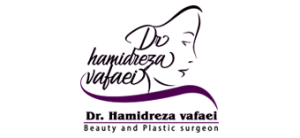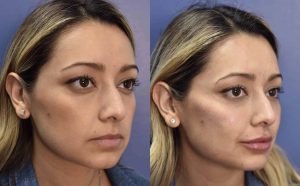cheek reshaping
cheek reshaping surgery can work wonders for patients who would like to provide improved contour and balance among facial features. Chin augmentation can make the chin appear more prominent and give you a stronger profile, while cheek augmentation can add volume to the cheekbones for greater contour. Chin and/or cheek reshaping can do wonders for your entire facial aesthetic. Prominent well-shaped cheekbones are important in achieving a well-balanced face. Flat or underdeveloped cheekbones have several causes. They may be caused by the shape of the underlying bone or a lack of soft tissue (fat) over the cheekbone prominences. As we age, we lose fat from the face and cheeks, so that the malar prominence becomes bony. Cheekbone shape is also important to facial appearance and must be considered in deciding on the best treatment. In your consultation, a detailed photographic and sometimes 3D analysis will help with treatment planning.
Who Needs Cheek Augmentation?
The cheeks are one of the three main landmarks of the face: chin, nose, and cheeks. When one of these is out of proportion, the whole facial structure may seem unbalanced. Cheek augmentation can correct this imbalance if you have shallow cheekbones. This can be the result of heredity or the re-absorption of bone tissue that occurs with aging. Candidates for cheek augmentation and reshaping will likely have a flat, hollow look about their cheeks and often the eyes, which are better defined with higher, more prominent cheekbones. An ideal candidate for cheek augmentation is in good physical health, is psychologically stable, and has a desire to add definition to the upper face. Prospective patients should have a clear understanding of the healing process, the limitations of the cheek augmentation procedure, and realistic expectations for their desired results. Finally, you should discuss your known allergies with your plastic surgeon to ensure the implant material is safe for you to use.
Am I a Good Candidate for Cheek reshaping?
Cheek reshaping is a highly individualized procedure. It can be a life-changing procedure for patients who are self-conscious about their cheeks. This procedure can be done for yourself, not for someone else or to conform with any sort of ideal image.
In general, you may be a good cheek augmentation candidate if:
- You are physically healthy and at a stable weight
- You have realistic expectations
- You are a nonsmoker
- You are bothered by the appearance of your cheeks
- You have cheeks that are too flat, thin or saggy
If you’re considering surgery, spend some time reviewing cheek augmentation photos and learning about what to expect during recovery. Preparation ahead of time helps patients have reasonable expectations and a smoother recovery.
What are the risks of cheek reshaping?
The possible risks of cheek reshaping consist of:
- Bleeding
- Infection
- Poor healing of incisions
- Hematoma
- Anesthesia risks
- Fluid accumulation (seroma)
- Skin loss
- Numbness or other changes in skin sensation
- Skin discoloration and/or prolonged swelling
- Unfavorable scarring
- Fatty tissue found deep in the skin might die (fat necrosis)
- Fatty cysts
- Deep vein thrombosis, cardiac and pulmonary complications
- Thick scar tissue around cheek implant (capsular contracture)
- Cheek implant displacement
- Asymmetry
- Lumpiness
- Blindness (a rare complication of fat transfer)
- Suboptimal aesthetic result
- Possibility of revisional surgery
- Persistent pain
- Poor aesthetic result of donor site for fat transfer
These risks and others will be fully discussed prior to your consent. It’s important that you address all your questions directly with your plastic surgeon.
How should I prepare for cheek reshaping?
In preparing for cheek reshaping, you may be asked to:
- Get lab testing or a medical evaluation
- Take certain medications or adjust your current medications
- Stop smoking
- Avoid taking aspirin, anti-inflammatory drugs, and herbal supplements as they can increase bleeding
Cheek reshaping is typically performed in a hospital, licensed ambulatory surgery center or in-office procedure room, and will use either general anesthesia, intravenous sedation or local anesthesia. In case your cheek reshaping would be performed using general anesthesia or intravenous sedation, be sure to arrange for someone to drive you to and from surgery and to stay with you for at least the first night following surgery.
What are the steps of a cheek reshaping procedure?
A cheek reshaping procedure includes the following steps: Medications are administered for your comfort during the surgical procedure. The choices consist of local anesthesia, an intravenous painkiller, and general anesthesia. Your doctor will recommend the best choice for you. A cheek augmentation requires different incisions based on the technique which will be used. If the fat transfer is used to enhance your cheeks, you will likely have a small incision near the area of fat that is harvested and small incisions near your cheeks. These incisions usually measure just several millimeters in length. If solid cheek implants are used, then the incision is based on your surgeon’s preferred approach. Some plastic surgeons insert cheek implants through an incision inside the mouth, whereas other plastic surgeons perform the operation through an incision under your eyelid. Sutures, skin adhesives or tapes close the skin incisions.
Your cheek reshaping will result in fuller and possibly softer-appearing cheeks. Some patients find that their cheeks can even appear lifted. The results of solid cheek implants are permanent, whereas the results from fat transfer may last several years.
What should I expect during my cheek reshaping recovery?
Following your cheek reshaping surgery, gauze dressings or bandages may be applied to your incisions. An elastic bandage or compression garment may minimize swelling and support the cheeks as they heal the following surgery. Alternatively, you may not have any dressings or bandages. If you have cheek implants placed through an incision inside your mouth, you may be placed on a liquid diet and/or given special mouth rinses.
You will be given specific instructions that may include:
- How to care for your surgical site following surgery
- Medications to apply or take orally to aid healing and reduce the risk of infection
- Specific concerns to look for at the surgical site or in your general health
- When to follow up with your plastic surgeon.
Be sure to ask your plastic surgeon specific questions about what you can expect during your individual recovery period.
- Where will I be taken after my surgery is complete?
- What medication will I be given or prescribed after surgery?
- Will I have dressings/bandages after surgery? When will they be removed?
- When can I bathe or shower?
- When can I resume normal activity and exercise?
- When do I return for follow-up care?
- Do I need to be on a specific diet after surgery?
Healing will continue for a couple of weeks as swelling decreases. Continue to follow your plastic surgeon’s instructions and attend follow-up visits as scheduled.










Leave a Reply
Want to join the discussion?Feel free to contribute!